+ Open data
Open data
- Basic information
Basic information
| Entry | Database: PDB / ID: 3j3i | ||||||
|---|---|---|---|---|---|---|---|
| Title | Penicillium chrysogenum virus (PcV) capsid structure | ||||||
 Components Components | Capsid protein | ||||||
 Keywords Keywords | VIRUS / double-stranded RNA / fungal virus / viral structure / T=1 virus / duplicated helical fold | ||||||
| Function / homology | : / : / Fungal virus Capsid protein, N-terminal domain / Fungal virus Capsid protein, C-terminal domain / T=1 icosahedral viral capsid / Capsid protein Function and homology information Function and homology information | ||||||
| Biological species |  Penicillium chrysogenum virus Penicillium chrysogenum virus | ||||||
| Method | ELECTRON MICROSCOPY / single particle reconstruction / cryo EM / Resolution: 4.1 Å | ||||||
 Authors Authors | Luque, D. / Gomez-Blanco, J. / Garriga, D. / Brilot, A. / Gonzalez, J.M. / Havens, W.H. / Carrascosa, J.L. / Trus, B.L. / Verdaguer, N. / Grigorieff, N. ...Luque, D. / Gomez-Blanco, J. / Garriga, D. / Brilot, A. / Gonzalez, J.M. / Havens, W.H. / Carrascosa, J.L. / Trus, B.L. / Verdaguer, N. / Grigorieff, N. / Ghabrial, S.A. / Caston, J.R. | ||||||
 Citation Citation |  Journal: Proc Natl Acad Sci U S A / Year: 2014 Journal: Proc Natl Acad Sci U S A / Year: 2014Title: Cryo-EM near-atomic structure of a dsRNA fungal virus shows ancient structural motifs preserved in the dsRNA viral lineage. Authors: Daniel Luque / Josué Gómez-Blanco / Damiá Garriga / Axel F Brilot / José M González / Wendy M Havens / José L Carrascosa / Benes L Trus / Nuria Verdaguer / Said A Ghabrial / José R Castón /   Abstract: Viruses evolve so rapidly that sequence-based comparison is not suitable for detecting relatedness among distant viruses. Structure-based comparisons suggest that evolution led to a small number of ...Viruses evolve so rapidly that sequence-based comparison is not suitable for detecting relatedness among distant viruses. Structure-based comparisons suggest that evolution led to a small number of viral classes or lineages that can be grouped by capsid protein (CP) folds. Here, we report that the CP structure of the fungal dsRNA Penicillium chrysogenum virus (PcV) shows the progenitor fold of the dsRNA virus lineage and suggests a relationship between lineages. Cryo-EM structure at near-atomic resolution showed that the 982-aa PcV CP is formed by a repeated α-helical core, indicative of gene duplication despite lack of sequence similarity between the two halves. Superimposition of secondary structure elements identified a single "hotspot" at which variation is introduced by insertion of peptide segments. Structural comparison of PcV and other distantly related dsRNA viruses detected preferential insertion sites at which the complexity of the conserved α-helical core, made up of ancestral structural motifs that have acted as a skeleton, might have increased, leading to evolution of the highly varied current structures. Analyses of structural motifs only apparent after systematic structural comparisons indicated that the hallmark fold preserved in the dsRNA virus lineage shares a long (spinal) α-helix tangential to the capsid surface with the head-tailed phage and herpesvirus viral lineage. | ||||||
| History |
|
- Structure visualization
Structure visualization
| Movie |
 Movie viewer Movie viewer |
|---|---|
| Structure viewer | Molecule:  Molmil Molmil Jmol/JSmol Jmol/JSmol |
- Downloads & links
Downloads & links
- Download
Download
| PDBx/mmCIF format |  3j3i.cif.gz 3j3i.cif.gz | 174.7 KB | Display |  PDBx/mmCIF format PDBx/mmCIF format |
|---|---|---|---|---|
| PDB format |  pdb3j3i.ent.gz pdb3j3i.ent.gz | 132.7 KB | Display |  PDB format PDB format |
| PDBx/mmJSON format |  3j3i.json.gz 3j3i.json.gz | Tree view |  PDBx/mmJSON format PDBx/mmJSON format | |
| Others |  Other downloads Other downloads |
-Validation report
| Summary document |  3j3i_validation.pdf.gz 3j3i_validation.pdf.gz | 1.1 MB | Display |  wwPDB validaton report wwPDB validaton report |
|---|---|---|---|---|
| Full document |  3j3i_full_validation.pdf.gz 3j3i_full_validation.pdf.gz | 1.1 MB | Display | |
| Data in XML |  3j3i_validation.xml.gz 3j3i_validation.xml.gz | 38.7 KB | Display | |
| Data in CIF |  3j3i_validation.cif.gz 3j3i_validation.cif.gz | 54.9 KB | Display | |
| Arichive directory |  https://data.pdbj.org/pub/pdb/validation_reports/j3/3j3i https://data.pdbj.org/pub/pdb/validation_reports/j3/3j3i ftp://data.pdbj.org/pub/pdb/validation_reports/j3/3j3i ftp://data.pdbj.org/pub/pdb/validation_reports/j3/3j3i | HTTPS FTP |
-Related structure data
| Related structure data |  5600MC M: map data used to model this data C: citing same article ( |
|---|---|
| Similar structure data |
- Links
Links
- Assembly
Assembly
| Deposited unit | 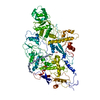
|
|---|---|
| 1 | x 60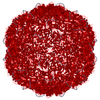
|
| 2 |
|
| 3 | x 5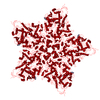
|
| 4 | x 6
|
| 5 | 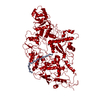
|
| Symmetry | Point symmetry: (Schoenflies symbol: I (icosahedral)) |
- Components
Components
| #1: Protein | Mass: 108952.219 Da / Num. of mol.: 1 / Source method: isolated from a natural source Source: (natural)  Penicillium chrysogenum virus (isolate Caston) Penicillium chrysogenum virus (isolate Caston)References: UniProt: Q8JVC1 |
|---|
-Experimental details
-Experiment
| Experiment | Method: ELECTRON MICROSCOPY |
|---|---|
| EM experiment | Aggregation state: PARTICLE / 3D reconstruction method: single particle reconstruction |
- Sample preparation
Sample preparation
| Component | Name: Penicillium chrysogenum virus / Type: VIRUS / Details: icosahedral |
|---|---|
| Molecular weight | Value: 6.5 MDa / Experimental value: NO |
| Details of virus | Empty: NO / Enveloped: NO / Host category: FUNGI / Isolate: STRAIN / Type: VIRION |
| Natural host | Organism: Penicillium chrysogenum / Strain: ATCC 9480 |
| Buffer solution | Name: 50 mM Tris-HCl, pH 7.8, 150 mM NaCl, 5 mM EDTA / pH: 7.8 / Details: 50 mM Tris-HCl, pH 7.8, 150 mM NaCl, 5 mM EDTA |
| Specimen | Embedding applied: NO / Shadowing applied: NO / Staining applied: NO / Vitrification applied: YES / Details: 50 mM Tris-HCl , 150 mM NaCl, 5 mM EDTA |
| Specimen support | Details: C flat CF 1/2 4C grids |
| Vitrification | Instrument: FEI VITROBOT MARK II / Cryogen name: ETHANE / Humidity: 80 % Details: Samples were applied to grids, blotted 7 seconds, and plunged into liquid ethane (FEI VITROBOT MARK II). Method: Blot for 7 seconds before plunging |
- Electron microscopy imaging
Electron microscopy imaging
| Experimental equipment |  Model: Tecnai F30 / Image courtesy: FEI Company |
|---|---|
| Microscopy | Model: FEI TECNAI F30 / Date: Feb 23, 2012 |
| Electron gun | Electron source:  FIELD EMISSION GUN / Accelerating voltage: 300 kV / Illumination mode: FLOOD BEAM FIELD EMISSION GUN / Accelerating voltage: 300 kV / Illumination mode: FLOOD BEAM |
| Electron lens | Mode: BRIGHT FIELD / Nominal magnification: 58333 X / Calibrated magnification: 56910 X / Nominal defocus max: 3800 nm / Nominal defocus min: 1100 nm / Cs: 2 mm / Camera length: 0 mm |
| Specimen holder | Specimen holder model: GATAN LIQUID NITROGEN / Tilt angle max: 0 ° / Tilt angle min: 0 ° |
| Image recording | Electron dose: 25 e/Å2 / Film or detector model: KODAK SO-163 FILM |
| Image scans | Num. digital images: 650 |
| Radiation | Protocol: SINGLE WAVELENGTH / Monochromatic (M) / Laue (L): M / Scattering type: x-ray |
| Radiation wavelength | Relative weight: 1 |
- Processing
Processing
| EM software | Name: Xmipp / Category: 3D reconstruction | ||||||||||||
|---|---|---|---|---|---|---|---|---|---|---|---|---|---|
| CTF correction | Details: Phase flipping & amplitude | ||||||||||||
| Symmetry | Point symmetry: I (icosahedral) | ||||||||||||
| 3D reconstruction | Method: Projection Matching / Resolution: 4.1 Å / Resolution method: FSC 0.143 CUT-OFF / Num. of particles: 27566 / Nominal pixel size: 1.2 Å / Actual pixel size: 1.23 Å / Details: (Single particle--Applied symmetry: I) / Symmetry type: POINT | ||||||||||||
| Refinement step | Cycle: LAST
|
 Movie
Movie Controller
Controller





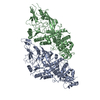





 PDBj
PDBj
